what is
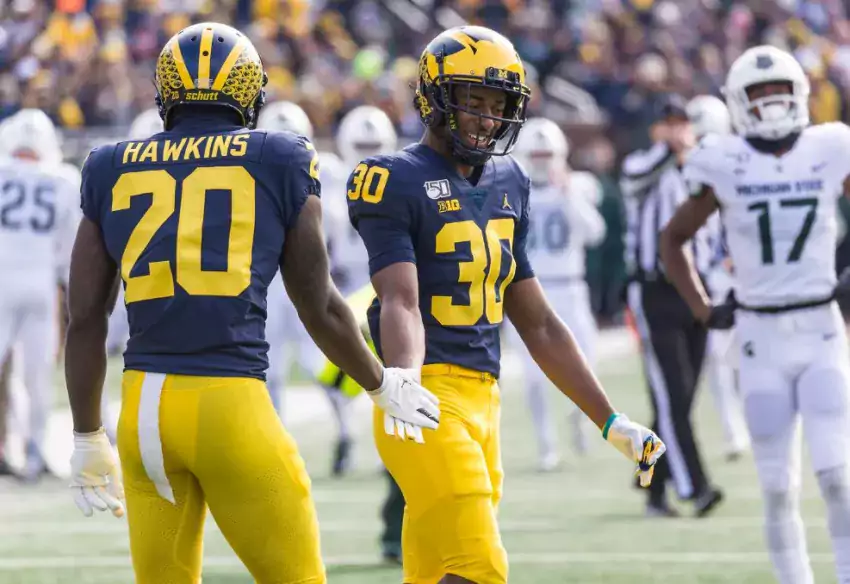
Usually in this space I like to talk about a thing that Michigan did differently to confound their opponent or add to the toolkit. This week, after a game when Harbaugh and his staff thoroughly outclassed Dantonio and his in all three phases, I'd like to discuss a thing Michigan has had in their kit for as long as Don Brown has been here, and how Michigan State came in with a gameplan to defeat it (and yes, how Michigan adjusted and went back to dominating).
That's because so many people were talking before, during, and after this game about Michigan's passing down coverage, what Gus Johnson, Joe Klatt and Urban Meyer were calling "Brackets Coverage" and which Brown, James Light, and this space shall call "Doubles."
Doubles Coverage
Unfortunately the guy who did the best job of explaining how Michigan prefers to defend passing downs was Urban Meyer, right before this game, so let's see what he had to say (I recommend the full video on Fox):
He's simplifying it, Urban's spread offensive mind thinking of it in terms of numbers: more defenders than offensive players over here, and over here, win: defense. But the basic gist of doubles coverage is understandable to every kid who's ever played playground football: play man and use the safeties to double-team two of the most likely receivers:
Even on this level, who gets doubled is the important part; the how they get doubled is getting into the weeds.
[Which we shall, after THE JUMP]
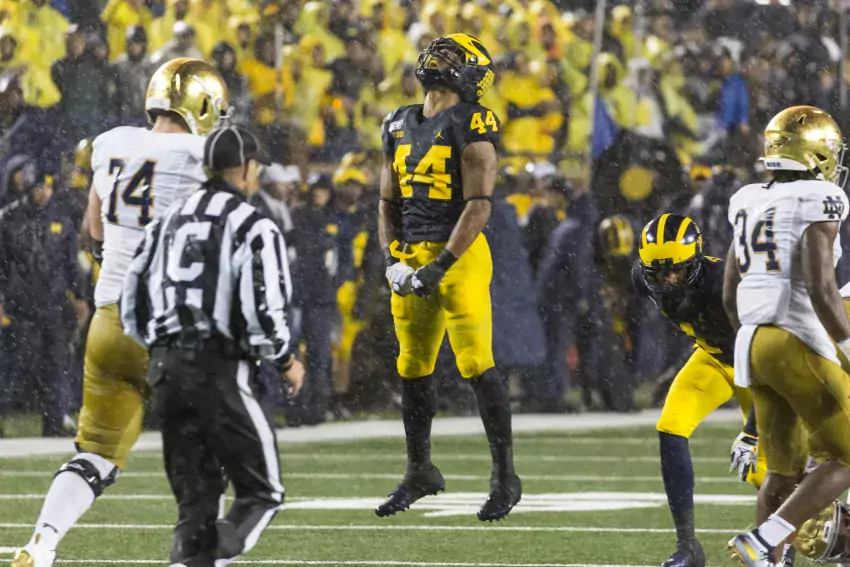
This series is a work-in-progress glossary of football concepts we tend to talk about in these pages. Previously:
Offensive concepts: RPOs, high-low, snag, mesh, covered/ineligible receivers, Duo, zone vs gap blocking, zone stretch, split zone, pin and pull, counter trey, inverted veer, reach block, kickout block, wham block, Y banana play, TRAIN, the run & shoot
Defensive concepts: The 3-3-5, Contain & lane integrity, force player, hybrid space player, no YOU’RE a 3-4!, scrape exchange, Tampa 2, Saban-style pattern-matching, match quarters, Dantonio’s quarters, Don Brown’s 4-DL packages and 3-DL packages, Bear
Special Teams: Spread punt vs NFL-style
We've been throwing around a term for how Michigan is playing defense this year a lot lately and haven't stopped to explain what it means: Playing to Spill.
Definition
Playing to spill is a defensive technique where the force player (edge defender) dives inside of a kickout block while another defender pops outside. This is done on the fly, usually against power runs, as a way to screw up blocking assignments and force the ballcarrier into this now-unblocked outside defender.
A play
So Maryland—not for the reason you might think—runs an offense extremely similar to Michigan's. Particularly this week they were heavy into arc zone read and its counter, split zone, plus pin and pull and its flipside, Counter Trey. We've discussed Counter Trey on here a bunch. It's Pin & Pull the opposite direction with some counter action in the backfield to get the defense stepping to the frontside before you swing the ballcarrier and a few escorts to the backside.
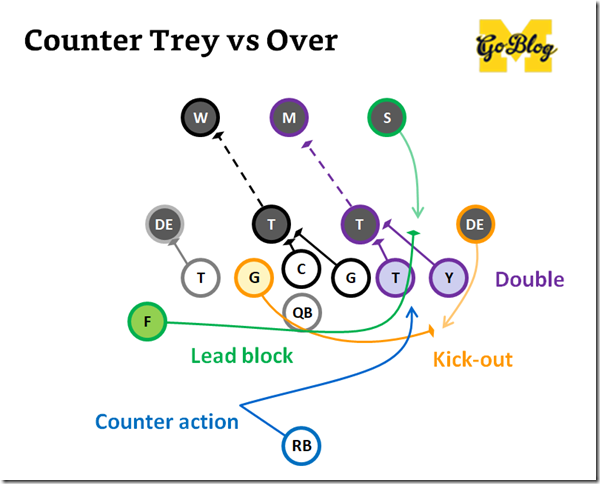
Locksley's Terps will kindly demonstrate this for us:
This is vintage Locksley: trying to get you thinking about a run one way so you're not paying attention when it goes the other way, then he thunks your edge guy outside, pins you inside, and rips somebody's heart out. On this play you see the tight end come across the formation and the running back step that way like it's going to be that edge pitch Penn State liked to run, and it's a surprise when the ball goes the other direction. Michigan's defense wasn't fooled however.
Remember, the pulling guard coming across the formation is trying to kick out Aiden Hutchinson, DE #97 on the top of the line. I want you to pay close attention to Aiden's response to the kickout. The pulling guard wants Aiden standing outside all passively. Aiden has other plans; he sees the guard coming…
…and leaps inside of him:
Aiden has now placed himself in the intended running lane. But this is Maryland's most base play, and the guard doing the kicking knows how to respond to this: turn the end inside. If you recall Michigan was doing the same thing on their pin & pulls versus Illinois.
The difference is here Michigan's defense has an edge.
[After THE JUMP: a scrape exchange for power]

This series is a work-in-progress glossary of football concepts we tend to talk about in these pages. Previously:
Offensive concepts: RPOs, high-low, snag, mesh, covered/ineligible receivers, Duo, zone vs gap blocking, zone stretch, split zone, pin and pull, inverted veer, reach block, kickout block, wham block, Y banana play, TRAIN, the run & shoot
Defensive concepts: The 3-3-5, Contain & lane integrity, force player, hybrid space player, no YOU’RE a 3-4!, scrape exchange, Tampa 2, Saban-style pattern-matching, match quarters, Dantonio’s quarters, Don Brown’s 4-DL packages and 3-DL packages, Bear
Special Teams: Spread punt vs NFL-style
So counter trey and its counter, BASH, are a pair of offensive concepts we're going to see more of, possibly from and certainly against Michigan. While things like it were part of the Single Wing offenses of the early 20th century, Tom Osborne's Nebraska teams really made Counter Trey a staple of power running. Michigan ran a bunch of counter under Drevno, and while they moved away from it last year, it has come up often lately in opponent scouting, most prominently in the Maryland offense when Mike Locksley was the OC. Since Locksley is now their HC, and because I know Gattis saw it plenty under Locksley last year, and Ohio State was doing it a bunch last year, I figured it would be a good time to cover these concepts so you can ID them when they come, starting with the ol' favorite, Counter Trey.
THE CONCEPT:
Counter Trey is a slow-developing counter run where you block down on the playside tackle and pull multiple guys from the backside for the two crucial frontside defenders: a guard to kick out an unblocked edge defender, and another guy from the backside (usually a TE or a tackle) to lead block into the frontside linebacker, with the back cutting off that block in the hole.
The plan here is to 1) Block down on the playside tackle, doubling to the MIKE, thus setting the inside wall of the gap. 2) Kick out the playside DE with the backside pulling guard to pry open the other side of the gap, 3) Bring a second puller (backside TE or OT) as lead blocker through the gap to take out the playside LB, and 4) Have the running back take a false step to freeze defenders to the backside, then cut behind the second puller and follow into the gap.
This definition gets controversial because it has expanded over the years. Voters in my informal twitter poll were split evenly between the definition above and any play with counter action and a puller, with a pedantic handful who stick to Osborne's original terminology. For our purposes I use the definition by Ross Fulton…
Anything that trades the responsibilities of power, such that the backside guard is kicking out and the backside T or Y-off is leading
— Ross Fulton (@RossRFulton) July 26, 2019
…plus counter action.
"Counter" in this sense refers to the initial motion of the back(s)—the running back will start the play with a short step counter to the flow of the play, serving as a fakeout to freeze any linebackers reading backfield motion, plus something to do in that second while the blocking is getting set up. "Trey" came out of Osborne's terminology for combination blocks: "Trey" meant a tackle+TE double-team. "Deuce" was a guard+tackle, and "Ace" was center+guard combo. I'm sure you can dig up a coach who swears a T/G double-team is "Counter Deuce" but to most "Trey" means backside guard->kickout+backside lead puller, kind of like how "secondary" has lost its meaning as "second level of defense" and become synonymous with defensive backs. As you can see in the drawing above, Osborne's terms made sense in a world full of fullbacks and tight ends. As we're about to find, this concept is so adaptable that you see it all the time today with no such things.
[After THE JUMP: How to spot it, how to defend it, what they do with it]
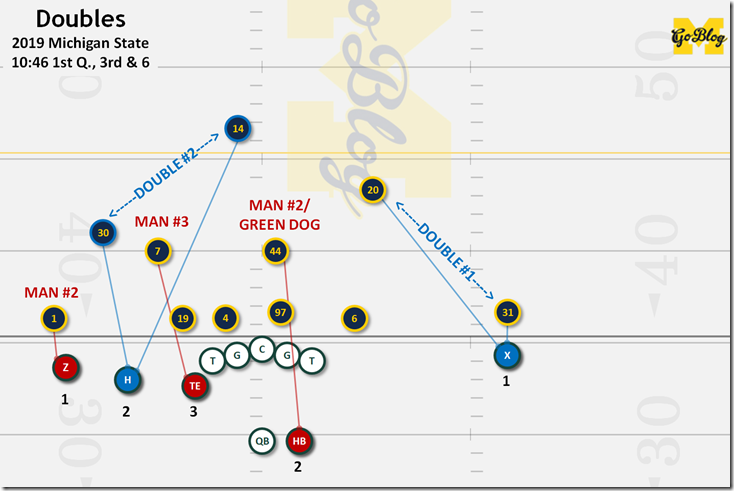

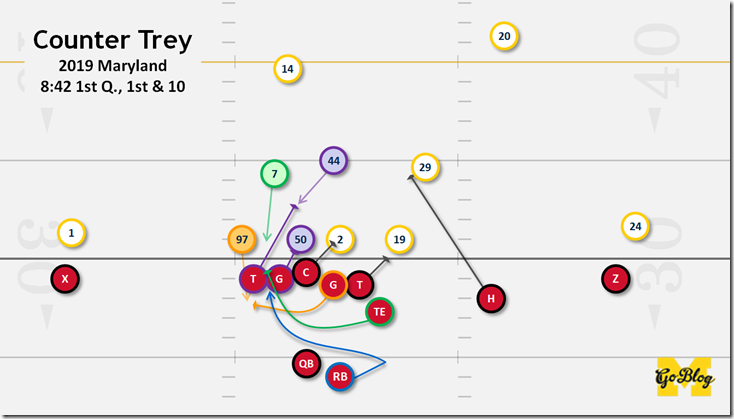


51